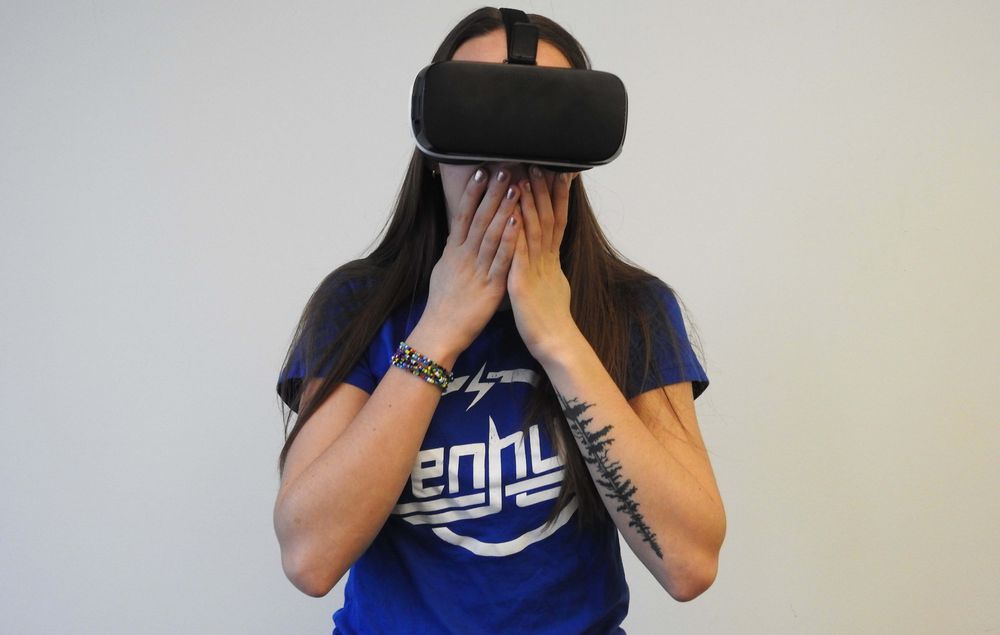Virtual reality: Bringing us closer to nature
You’ve transformed into a chicken. Feathers and a darting head. Looking down, you see your chicken feet. Surrounded by the noises of clucking, whirring machinery, and the shuffling of your chicken friends. Are you dreaming? Or was that virtual reality (VR)?
Vegan activists, directors, and artists are embracing technologies to give us insights into the lives of animals. I, Chicken, is a VR experience whereby you are a cartoon chicken going through your day. Eating, walking, and finally on the conveyor belt up to the machinery that will kill you. Participants have reported feeling more empathetic towards the plight of a farmed chicken due to gaining a closeness with the animal’s situation.
If you are unfamiliar with the impact of using a VR headset, let me give you an example of how dramatic it can feel: I click on a channel, not knowing where I would find myself. I was standing in a helicopter, travelling over canyons. It felt so realistic, I had to take my headset off as I’m scared of heights.
Don’t worry, not all VR is scary. I use a dance game that allows me to be a bad dancer in the privacy of my bedroom: I've travelled underwater with live footage iridescent rainbowfish circling me, and I’ve meditated in majestic forests.
VR’s immersive world-building tricks our brains into thinking it’s real. You are propelled into an immediacy that requires you to interact, and the heightened stimulation of being in an alternate 3D narrative is novel. You are compelled to give the experience your full attention.
I, Chicken was exhibited on a tour around American universities. Feedback from student participants supported the notion that it’s hard to empathise with animals when we are so far away from their journeys, and that this VR experience was an effective way of getting information out to people and changing their perceptions.
Animal Equality has developed iAnimal, which exposes factory farming via secret filming, via a 360-degree perspective of the lives of cows, pigs, and chickens. This is hard-hitting footage and has been taken to the streets to show the general public. Viewers not only see the plights these factory farmed animals face but are given the space to ask the campaigners questions, making people feel like they are part of the conversation. Combining VR with campaigning events can start to break down the barriers and help us to work collectively.
Another striking way VR can bring us closer to the animal world without the need for zoos or intruding on at-risk ecosystems, are immersive documentaries such as ecosphere, whereby you can “Explore the great savannahs of Kenya, discover the ancient jungles of Borneo and dive into the rich coral reefs of Raja Ampat”.
Last time I saw an elephant was many years ago in India. It was chained up. I was asked if I wanted to ride it - I didn’t. I wanted to see it doing its own thing, in its own environment, walking around, picking leaves. I’ve never wanted to visit an actor in a cage. I can happily watch them in a film. Experiencing ecosphere, I was face-to-face with an elephant. Its trunk curiously moved towards me. I was meters away from families of elephants, their relaxed pacing through the savannas of Kenya. I got a vivid sense of their enormity and got close enough to enjoy the sounds of them crunching leaves.
If we are to cut down on our carbon footprint and avoid flying, VR provides an alternative for exploration. Furthermore, not everyone can travel due to their circumstances - it provides insights for people in an accessible way. As an educational tool, it’s changing people’s perceptions: exposing animal mistreatment and allowing us to marvel at nature without exploiting or caging it.
If you’d like to find out more about how tech can be a driver for positive change, check out 5 wholesome environmental video games encouraging positive change and 10 apps changing the world.
